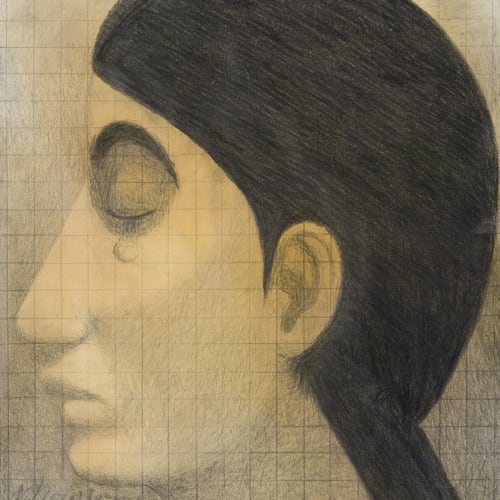Victor Newsome's current works are challenging in the sheer wilful singularity of their vision. Comprising full-face portraits of Jesus and the Virgin Mary, their grave, heavy-lidded, yet oddly indifferent eyes looking towards us, if not at us, their features near identical; they might justifiably be described as icon-like or comic-like, without either of these terms giving any idea of the effect they create. The tonal range is narrow, colours sombre and earthy, forms clearly defined through deep shading. The impact is rhythmic, hypnotic, the use of heavy, overlain blacks recalling the ritual processes of ancient Egyptian art. Yet if these images bring to mind the wax portraits seen on Coptic Era mummies - a postcard of one of which hangs in Newsome's studio - those faces, with their large, lustrous black eyes attempt individualised likenesses. Newsome's images are hieratic: attempts to create the stylised idea of a person that may have full meaning only for the artist himself.
An image lying on a table in Newsome's studio provides a clue to the intentions of his Saviours and Madonnas: a newspaper picture of Osama bin Laden.
Intrigued by the story of a virgin birth to a Komodo Dragon at Colchester Zoo shortly before Christmas 2006, Newsome began recreating in his mind the circumstances of the most famous virgin birth, and the events that proceeded from it, in a matter-of-fact manner appropriate to a creator of images. These were Middle Eastern people, Newsome reasons. Mother and son would have looked very alike. Bin Laden's is one of many faces that have fed into this stream of images - along with Anne Frank, Kate Moss and an anonymous Iranian woman condemned to death for adultery.
Newsome's images have developed through a long process of repetition and refinement. They have no overt religious intent, but have been brought into being simply to create the most powerful image possible. Newsome's responsibility is to art, not spirituality. While they confirm Newsome's sense of himself as part of a long tradition of representational art, their concern with typology, with finding a collective image that will 'allow the mind to work on other levels', as Jasper Johns put it, feel very contemporary.
Mark Hudson, 2012


